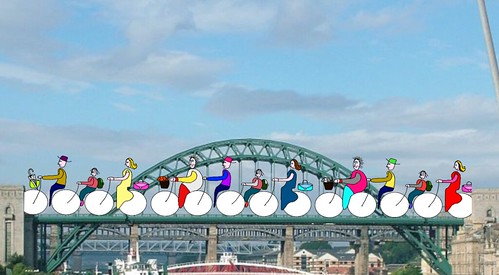
Monday, 29 July 2013
Sunday, 21 July 2013
Going Dutch - by helicopter
One of Newcastle's notorious blackspots (no-one walks or cycles there without fear or intimidation) is Blue House Roundabout. It's best to get across by helicopter (which may not quite be the best environmental, or socially or economically feasible, way of travel). On a recent visit the Cycle Embassy of Great Britain was not impressed
with the ease of navigation by bicycle at this location.
Yet, Blue House gyratory is on the Gosforth Strategic Cycle Route (now locally known as SCR 4) and the Great North Cycleway (NCN725) where people-friendly designs should be more easily forthcoming. Hello Sustrans, are you going to say something? (City Centre, nudge nudge.)
New plans I have seen look like they have little for cycling 'convenience' where pedallers are probably lumped in with pedestrians once more (just like the latest Central Station plans). Neither does the site fare well for pedestrians with its proposed multiple stage crossings. Be prepared to emerge ten year older when re-surfacing on the other side of this dead space. Hello 1960s! The Grand Age of Motoring is back. And funding has been allocated through the LTP (as also for Haddrick Mill and Cowgate gyratories).
This is terrifying.
But - salvation trumpets - the Dutch are coming to Newcastle, hungry to fill us in on their cycle infrastructure knowledge. Solutions are there of course. The space is there (of course) - luckily at this location, without starving the Sacred Cow of traffic flow.
Current:

Proposed:

Overlay:

Yet, Blue House gyratory is on the Gosforth Strategic Cycle Route (now locally known as SCR 4) and the Great North Cycleway (NCN725) where people-friendly designs should be more easily forthcoming. Hello Sustrans, are you going to say something? (City Centre, nudge nudge.)
New plans I have seen look like they have little for cycling 'convenience' where pedallers are probably lumped in with pedestrians once more (just like the latest Central Station plans). Neither does the site fare well for pedestrians with its proposed multiple stage crossings. Be prepared to emerge ten year older when re-surfacing on the other side of this dead space. Hello 1960s! The Grand Age of Motoring is back. And funding has been allocated through the LTP (as also for Haddrick Mill and Cowgate gyratories).
This is terrifying.
But - salvation trumpets - the Dutch are coming to Newcastle, hungry to fill us in on their cycle infrastructure knowledge. Solutions are there of course. The space is there (of course) - luckily at this location, without starving the Sacred Cow of traffic flow.
Current:

Proposed:

Overlay:

Friday, 19 July 2013
Shake off the shackles

So many meetings this week; and so many people talking to me again about wanting see car use seriously curbed for a better and safer environment. I think politicians are blinded to evidence and so-called expert advice (highway engineers) - local politicians particularly. (Nationally there might be more evil conspiratory forces at work, with big corps 'stuffing fat cat politicians pockets'. And we all know the more money you've got the unkinder you get... )
In Newcastle access to a car is low - 40% of households do not have one. There are huge health inequalities between neighbouring wards. Public transport can be expensive and cycling is seriously unpleasant, with walking covering effectively a journey distance 1.5 miles before being too slow and restricting your movement radius.
This week I also listened to a talk from a university professor looking at pollution, traffic and climate change modelling (and their interactions) who had come to the only conclusion that curbing the car was the answer, it's driving us in the ground. No, even e-cars are not saving us.
Meeting a mum whose son was killed when cycling, it is still ringing in my ear when she said "I saw the bastard again the other day. He's still out there, driving." When all she wanted him, quite understandably, to be removed from the road. But in our society there is no justice for people travelling by non-car means, she was finding out the hard way. She held back her tears bravely.
Here's Newcastle's public realm story in an other's words:
The 1950s was the last decade of the slow and gradual evolution of Newcastle. At this time the roads and streets were much as they had been laid out in the 19th century and earlier. On them the electric powered trolley bus was still the prime mover of people about the city but it was already being challenged by the motor bus and was to disappear altogether by 1966.And and article in The Times says there is no place for cars in cities.
The growth in personal motoring and the unrestricted access to the city centre was as elsewhere beginning to cause problems. The solutions which were to be employed in the 1960 and 1970s were to transform the appearance of much of the city for good or ill.
Source youtube
Monday, 15 July 2013
Saturday, 13 July 2013
ICE breaker
From: Katja Leyendecker
Date: 28 June 2013
Subject: Crossroads
To: NCE Editorial
Isn't it a bit naive of [the President of the Institution of Civil Engineers] Barry Clarke to call for Ethics in Engineering when the Institution is still part of the obnoxiously overbearing road lobby, as could be seen in the SoN Transport report.
Build it, clog it up, build more. Repeat again. Perpetuating the pipe dream of unlimited resources.
Although - I must congratulate the Institution on the comments on liveable cities and cycling infrastructure.
Crossroads? Where to go? Where does sustainability and resilience "fit in" with the ICE?
KATJA LEYENDECKER

Previously on the same channel of professional institutions - ICE also say good things about cycling as these groups rightly acknowledge.
@newcycling
@gbcycleembassy
Yes, it is confusing too. As the original letter title says; crossroads.
Sunday, 7 July 2013
Subscribe to:
Comments (Atom)
